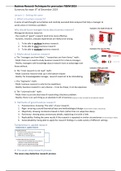Samenvatting
Summary: Business Research Techniques for Premaster Marketing Management TiSEM 2019
- Instelling
- Tilburg University (UVT)
This summary contains all information of the lectures of Business Research Techniques. Applicable for all premaster studies at TiSEM 2019 (Tilburg University). As preparation for the exam in December 2019.
[Meer zien]





